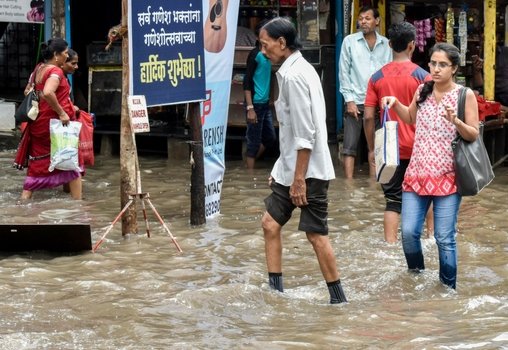On August 29, the monsoon fury unleashed on Mumbai and brought the city to a grinding halt. Two toddlers were among 14 people killed in the floods. It received nearly a month’s average rainfall in a single day —halting the transit lifeline of train services and leading to several flight cancellations. It continued for two more days until it finally subsided. This is touted to be the worst flooding since 2005 that saw the death of more than 500 people.
Over the last month, several other Indian cities witnessed above average rainfall. On the morning of August 21, Chandigarh had received 112 mm of rainfall, 23 times the city’s average daily monsoon rainfall. Similarly, on August 15, Bengaluru received 37 times, and on August 11–12 Agartala received more than 11 times its average daily monsoon rainfall in the last five years.
Vimal Mishra, a meteorologist and assistant professor at IIT Gandhinagar revealed in his research work that extreme rains are going to increase over the century. Specifically, he found that one-to-five-day extreme rains, at levels found once in about 500 years, can increase by about 20–30% over the next century if global warming goes unchecked. This prognosis does not augur well for a sizable population of poor and migrant community in these cities.
So, Who Actually Bears The Brunt?
Peculiar to Indian cities, a large number of rural folks migrate to these cities in search of work and livelihood. Many of them earn daily wages and end up sheltering in temporary squatter settlements or claustrophobic slum settlements. The city corporation have not been successful in providing basic amenities to them or even extend public infrastructural services like drainage, drinking water or sanitation disposal facility. Rapid urbanisation and population growth has made the situation worse.
With increasing occurrence of extreme events, the adverse impact on health has compounded. A field study conducted in Mumbai by S. Kumar Karn and H. Harada from Nagaoka University of Technology, Japan found that at least 30% of all morbidity can be accounted for by water-related infections.
Such intermittent urban floods further aggravate the morbidity caused by water-borne diseases in the community. The children are especially vulnerable to water-borne diseases. Clogged drainage in sewage system carrying both storm-water and human waste poses a grave health risk. A sudden outpour inundates their homes with contaminated water exposing them to lethal faecal-oral diseases. They have no other way to go but stay.
Also, due to lack of ‘legal access’ to drinking water, many of the slum residents are forced to illegally tap into city water pipes out of desperation or access surface water bodies like lakes & rivulets. However, the water-bodies gets contaminated owing to flooding and become breeding ground for deadly pathogens. Diseases like cholera and diarrhoea among slum-dwelling children is mainly due to such source-point contamination. And unfortunately, the parents aren’t even aware of it.
Fallen Buildings
A recurrent theme for urban flooding disasters in Indian cities is the collapse of building structures due to incessant rains and administrative apathy. A day after Mumbai torrential rain started, a five-storeyed building collapsed in the congested Bhendi Bazar area of south Mumbai. At least 24 people were killed and another 34 were injured. Another building also had same fate last year.
Cities like Delhi and Chennai have also shared the same story at some point in time. A unique signature of old Indian cities is its fair share of old and dilapidated buildings, some of them being from the colonial past. In spite of being flagged off by civic authorities as unlivable and dangerous, people continue to live there. Following incessant rains, the groundwater table rises to pulverise the foundation of these buildings and make them unstable. The unbearable load further crushes the foundation column which finally gives way to collapsing the entire structure.
At a crisis situation like this, the first reaction is to get the affected to the closest hospital. But, are the hospitals ready to tackle the situation in a flood crisis?
Hospitals Need Help
In times of urban disaster or natural crisis, public hospitals project an image of chaos and confusion. Most of the public hospitals are situated close to low-lying urban settlements for ease of access and ironically, floods throw up challenges of their own kind. At times, the public health infrastructure gets incapacitated due to rains and flooding into the premises.
In one of the cases in a hospital in Chennai, the flooding of its power units led to failure of ventilators imminently led to the death of 18 patients. Such instances cannot be overlooked. Moreover, the logistical interruption by floods causes a delay in supply of critical medicines and health instruments that can prove to be expensive at such times. At times, it also restricts the movement of medical personnel in attending to the patients.
Another challenge is disposal of medical waste. The floods have high probability of carrying hazardous chemicals and infections to nearby population and further spread them.
Almost all of these challenges can be managed, provided civic authorities are foresighted to make the urban landscape resilient to climate change events and are adequately prepared for any disaster. The various agencies need to coordinate swiftly in terms of city-wise disaster management framework that alleviate confusion and foster cooperation. The natural flood protection systems like urban wetlands and rivers need to be preserved and maintained sustainably. They provide a cushion to absorb excess flood water. Ironically, sometimes it is the nature itself that can help the city-dwellers from nature’s fury.
